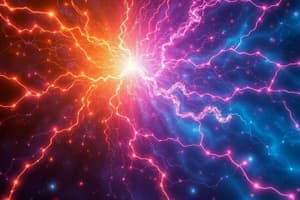Podcast
Questions and Answers
What is the fundamental unit that makes up a nerve pathway and sends messages to our body?
What is the fundamental unit that makes up a nerve pathway and sends messages to our body?
- Dendrite
- Neuron (correct)
- Myelin sheath
- Schwann cell
Which part of the neuron is responsible for receiving input from other neurons?
Which part of the neuron is responsible for receiving input from other neurons?
- Axon
- Myelin sheath
- Dendrite (correct)
- Glial cell
What is the term for the tiny-looking bubbles at the extreme end of an axon?
What is the term for the tiny-looking bubbles at the extreme end of an axon?
- Myelin sheath
- Schwann cell
- End bulbs (correct)
- Cell body
Which cells support neurons by insulating, synchronizing activities, and removing waste?
Which cells support neurons by insulating, synchronizing activities, and removing waste?
What speeds up the transmission of impulses along an axon?
What speeds up the transmission of impulses along an axon?
What is the process of converting physical or chemical energy to electrochemical messages called?
What is the process of converting physical or chemical energy to electrochemical messages called?
What is the tiny electric current generated when positive sodium ions rush inside the axon called?
What is the tiny electric current generated when positive sodium ions rush inside the axon called?
Which type of neurons carry information from the senses to the spinal cord?
Which type of neurons carry information from the senses to the spinal cord?
What does the autonomic nervous system regulate?
What does the autonomic nervous system regulate?
Which division of the autonomic nervous system prepares the body for action when triggered by threatening or challenging stimuli?
Which division of the autonomic nervous system prepares the body for action when triggered by threatening or challenging stimuli?
Which part of the nervous system contains the brain and spinal cord?
Which part of the nervous system contains the brain and spinal cord?
What is the primary task of interneurons?
What is the primary task of interneurons?
Flashcards are hidden until you start studying
Study Notes
Neurons and Nerve Pathways
- Neurons are the fundamental unit of nerve pathways, responsible for sending messages throughout the body.
- Dendrites are the parts of the neuron that receive input from other neurons.
Axon and Synapses
- Synaptic vesicles are the tiny-looking bubbles at the end of an axon, containing neurotransmitters that facilitate communication between neurons.
Supportive Cells
- Glial cells support neurons by insulating them, synchronizing neuronal activity, and removing waste products.
Impulse Transmission
- Myelin sheaths speed up the transmission of impulses along an axon, allowing for faster communication between neurons.
Signal Conversion
- The process of converting physical or chemical energy into electrochemical messages in neurons is known as transduction.
Action Potential
- The tiny electric current generated when positive sodium ions rush inside the axon is called an action potential.
Types of Neurons
- Afferent neurons carry sensory information from the senses to the spinal cord, facilitating the sensation process.
Autonomic Nervous System
- The autonomic nervous system regulates involuntary bodily functions, such as heart rate, digestion, and respiratory rate.
Sympathetic Division
- The sympathetic division of the autonomic nervous system prepares the body for action, especially in response to threatening or challenging stimuli.
Central Nervous System
- The central nervous system comprises the brain and spinal cord, serving as the main control center for processing information.
Role of Interneurons
- Interneurons primarily facilitate communication between sensory and motor neurons, playing a crucial role in reflexes and processing information.
Studying That Suits You
Use AI to generate personalized quizzes and flashcards to suit your learning preferences.




